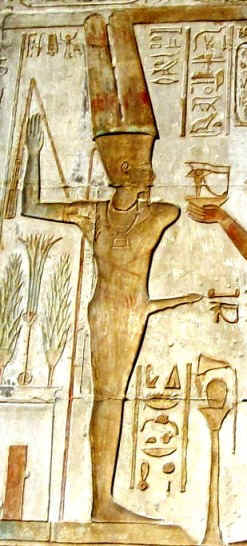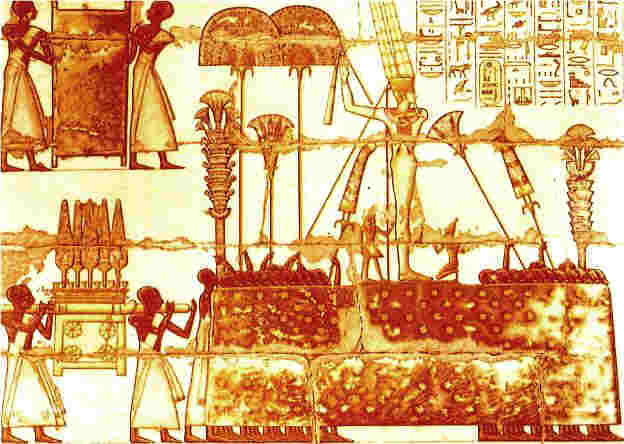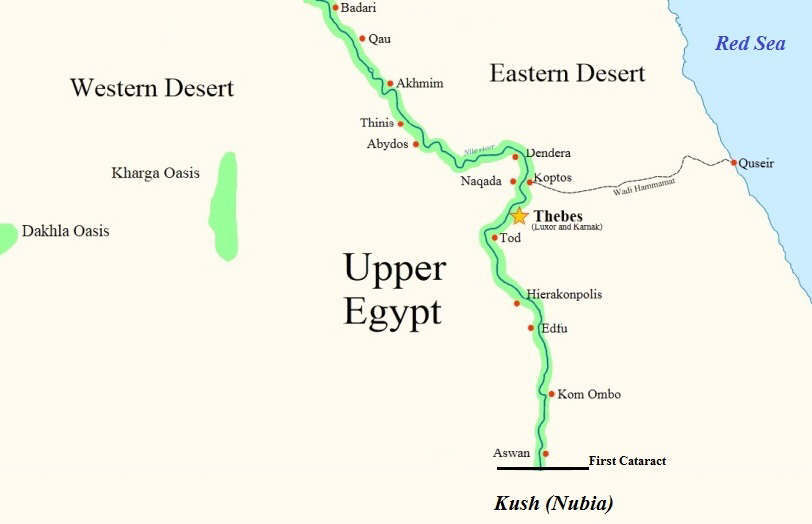
| Min, god of Egypt | 
|
|
Ancient Egyptian Gods and Goddesses for kids - Min The Mythology & History of ancient Egypt surrounding Min, the god of fertility and reproduction |
|
Min, god of Egypt
Discover the legends and myths and religious beliefs surrounding Min, the Egyptian god of fertility and sexual procreativity (reproduction), rain, the desert, miners and travellers. He was also considered a god of regeneration which is believed to symbolize the forceful renewal of the sovereignty of the pharaoh. Min was honored in the coronation rites of new pharaohs to ensure their sexual vigour and the production of a male heir. Min was depicted as a human male with one arm, one leg and a large, erect penis. He carried a flail and wore the Double Plumed Crown. Additional, interesting facts and information about ancient Egypt, and its mysterious gods and goddesses, is also available via: |
|
Who was Min?
Min was the Egyptian god of fertility and sexual procreativity depicted with a black colored skin and the flail of Egypt. Facts about Min
The following facts and profile provides a fast overview of Min:
Min Profile & Fact File | | Egyptian Name: | Min. Alternative Names: Mina, Menew, Menu, Amsu
| | Role & Function: | The roles of the god Min included duties associated with fertility, virility, rain, the desert and travellers
| | Symbols: | The lettuce, white bull, the flail, the ankh
| | Centers of Worship: | Koptos (Qift) and Akhmim (Panoplis)
| | Titles: | "Lofty of the Two Feathers ", the "Lord of Foreign Lands", "Maker of gods and men", "He whose arm is raised in the East" and the "Great of love"
| | Consort: | Qetesh, goddess of love and femininity
| | Name in Hieroglyphics: | | Translation of Hieroglyphics for Min: The 'arrow' emblem of Min, the symbol for carrying a standard and God with aroused phallus | 
|
|
|
|
Min - Egyptian gods & Mythology for Kids
Min the Egyptian god of fertlity, virility, rain, the desert and travellers, was one of the astonishing number of gods and goddesses worshipped by the Ancient Egyptians and images of Min depicted him a large, erect penis. The Egyptians were very open about sex and sensuality and this type of image was seen as quite acceptable. Min is also shown with the crown of Amun, and considered an aspect of the god Amun. The overall image of Min is typically depicted as a human male with one arm and one leg. This strange imagery was based on the mythology and legends associated with Min. In the ancient myth Min was charged with protecting a city in Egypt when the ruler and all the men of the city had to leave to undertake a military campaign. The women were left alone an needed a protector. When the ruler returned he found that all the women in the city pregnant. The god Amun punished Min for the abuse of his power by cutting off one leg and one arm. Henceforth Min was recognised as the one armed, one legged god with the large, erect penis. The Role of Min
The role and duties of Min were as: - God of male sexuality and sexual procreativity (reproduction)
- Min was honoured in the coronation rites of the pharaohs to ensure their sexual vigour and the production of a male heir
- God of fertility
- God of vegetation, crops and harvests
- Rainmaker
- God of the Eastern Desert
- God of stone - Min was venerated as the god of miners in the area around the river called the Wadi Hammamat that supplied the prized green sandstone, called bekhen-stone, used for bowls, palettes, statues, and sarcophagi stone for sarcophagus
- Protector of mining expeditions - the area around Wadi Hammamat was mined for gold and quartz
- Patron of roads, journeys, the desert and travellers

Picture of Min, the Temple of Hathor in El Medina The Symbols of Min
The symbols of Min include: - White bull symbolizing virility and strength
- Min’s sacred lettuce (Romaine or Cos lettuce)
- Black skin color. Although black was usually associated with death and night the ancient Egyptians also associated the color black with the fertility and regeneration of the land
- The Egyptians called the river Nile 'Ar' or 'Aur' meaning “Black,” in allusion to the color of the rich alluvial deposits carried by the river when it flooded.
- The 'Black Lands' were the farming areas on the banks of the Nile producing crops such as cereals, wheat and barley
- Min was associated with the desert and travellers - The Nubians were depicted in Egyptian art with black colored skin
- The Ankh representing eternal life
- The cypress tree, under which Min was said to have been worshipped.
- The double plumed crown
- Weapons of ancient Egypt
Harvest Festival of Min - the Feast of Dais
Min was a central god of vegetation and the Feast of the Dais was held in his honor. The harvest festival to Min was an important celebration attended by the pharaoh and the royal court. The pharaoh sitting on a canopied litter, his court, soldiers, standard bearers, fan bearers, dancers, musicians would form a great procession to his temple. The priests of Min also formed a large contingent in the procession, burning incense and carrying shrines and images of the pharaoh and his ancestors. Amazingly elaborate and ingeniously constructed floats formed part of the procession, similar to the floats of modern day parades. At the front pf the procession was a white bull, the symbol of Min, that had a sun-disk fastened between his horns representing Min himself. During the Feast of the Dais Min received the first wheat ear of the harvest that was cut by the pharaoh himself. Bouquets of flowers and the lettuce were also offered to Min. The following relief, from the funerary temple of Ramses III at Medinet Habu, shows the harvest festival of Min featuring a statue of Min, which formed a major part of the procession, behind the carnival float of Min. The cult of Min lasted for 3000 years and following the Roman conquest of Egypt the Roman Emperor Augustus was depicted offering lettuces to Min god in the temple of Kalabsha, aka the Temple of Mandulis, that was located approximately 50 km south of Aswan. 
The Sacred Lettuce of Min
The above picture of the procession float of Min depicts the main float followed by two priests. The priests carry sacred lettuce plants, the symbol of Min and similar in shape to our Kos or Romaine lettuce. The pointed-shaped lettuce plants are stylized and frequently appear in many images depicting Min. The wild prickly lettuce Lactuca virosa was domesticated and this version of the lettuce was Lactuca sativa which had both aphrodisiac and opiate qualities. The aphrodisiac qualities clearing connecting this plant to Min. |
|
Min- Information and interesting facts about MinMin
- Interesting research information and Facts about the Egyptian god Min
- Min, the Egyptian god of fertility
- Stories and Legends in Egyptian Mythology associated with Min
- Facts and information about the gods and deities of of classical Egypt for schools, research and kids
- Min, the Egyptian god of fertility
|
| | |
|
The Cult Centers of Min
The main centres of worship were Qift (Koptos) and Akhmim (Khemmis, Greek Panoplis). Min became identified with the Greek god Pan which led to the later name of Akhmim as ‘Panopolis’. Two of the titles of Min were the "Lord of Foreign Lands" and "God of the Eastern desert". The following map of Upper Egypt shows the location of his cults centers and their proximity to the desert areas of the region, the river called the Wadi Hammamat, and of Nubia. His chief center was Koptos (or Coptos) meaning the town of caravans. Koptos was a major departure point for trading expeditions and commercial ventures. The Wadi Hammamat was the major trade route east from the Nile Valley and Thebes to the Red Sea port of Elim, and then to the Silk Road that led to Asia, Arabia and the horn of Africa. 
Map of Upper Egypt desert areas, showing centers of worship for Min in Koptos, Akhim & the Wadi Hammamat |
|
|
|